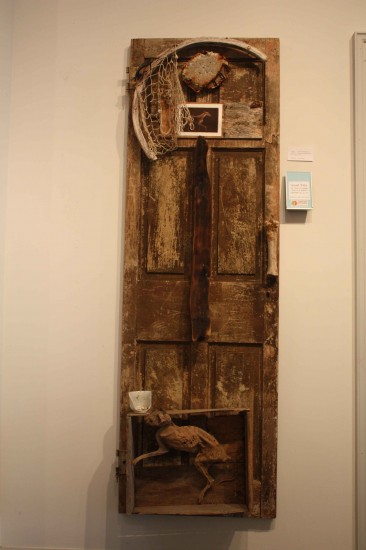One person’s garbage is another person’s insight into what it means to be alive in this world.
Everywhere we look we see the impulse toward artistic expression. I’m not talking about “The Arts” in quotes and caps, although everything from the paintings of Leonardo da Vinci to the pantings of Lady Gaga arise from this same impulse. I’m talking about that mysterious, rarely acknowledged drive in each of us to celebrate, to negotiate, to re-present our lived human experience. We scribble in the middle of tedious meetings. We hum to ourselves as we wash dishes. We tweet witty texts. We “Facebook” inventive poses. From ancient cave paintings and Bronze Age idols through to rugs hooked from rags and karaoke songs belted out of joy and yearning, art making for our species has always been and will remain as essential to life as eating.
Here’s a case in point: the “Art Made of Garbage Contest and Exhibition” at the Coastline Gallery in the Osprey Arts Centre in Shelburne, Nova Scotia. Full disclosure: I work very part time for the local Shelburne County Arts Council and pitched the idea to the board a couple of years ago. The concept excited us for many reasons. We live in a rural area – the population of the entire county is just over 15,000 – and the fine arts here are considered highfalutin. Here, as anywhere the community, we have a long and intimate relationship with the arts, but the practice tends to be craft related, functional or just plain fun. When we came up with the concept, we hoped to collide these traditional and accepted forms with a contemporary aesthetic.
It worked. The exhibition called “The Garbage Collection” is the best example I’ve ever seen of the urge to assemble art out of nothing but the detritus of human existence. In fact, one piece – a collage by two kids and an adult – is entitled “Human Flotsam.”
The pieces in the exhibition are varied, inventive and humourous. The show features beach glass assembled into jewellery, metal packing straps into a wobbly side table, broken glass and pottery into a mosaic on the roof of a birdhouse, pine needles woven into exquisite baskets, mats and gift bags crocheted from yarn made of plastic grocery bags.
One piece called “The Old Homestead” by visual artist Diane Rosati is an assemblage of bits of wood and bone she found around her property that features perhaps the oddest component in the show, a mummified cat she discovered in the basement of the old house she renovated. The piece took second prize. First prize went to university student Michael Campbell for his piece “Electronic Litter Bug”. It’s a flying beetle ingeniously constructed from discarded phone and computer parts.
The arts council commissioned three pieces, all of which are standouts for one reason or another. Sometime visual artist and gallery owner Timothy Gillespie built a cascading sculpture of old suitcases and trunks. Items of clothing fly in suspended animation from the suitcase at the teetering top of this precarious pile. Amateur blacksmith Hayward Meisner welded and smithed a gorgeous pond silhouette scene inside the metal ring of an old wagon wheel. And ceramic artist Alison Stanton built a chandelier from Barbie doll limbs and fashion accessories. The structure hangs from the ceiling by a dog’s choke chain.
As good as these pieces are, for many visitors to the exhibition one piece stands out over the rest. Emil Degenhardt’s compelling sculpture “Iron Man” received an Honourable Mention from the contest judges. Constructed of an old ironing board, an agitator from a washing machine, an enamel chamber pot, the head of a broom, some rusty screws and some other bits and pieces, Iron Man sports a potbelly made of a transparent bag of garbage. He epitomizes the exhibition and the very concept of art made from garbage. The sculpture seems thrown together as if a whirlwind picked up some roadside trash and gathered it into a human form.
The history of the ironing board itself is a lesson in ingenuity, art being its fourth and according to Emil its final incarnation. In a statement he gave the gallery, Emil wrote:
History
Meager beginnings 2000-2005 Ironing Board.
Garden Ornament 2005-2007 After not working any more we used as a float, pulled behind garden tractor to level off driveway.
A step up to art 2010 Iron Man (“Tin the Tool Man”) was created!
Emil’s piece is a perfect manifestation of both the spirit of irrepressible creativity the Art Made of Garbage Contest and Exhibition was meant to invoke — and the impulse to represent the human form. It reflects back to the viewer the instinctive drive in us all to express that elusive quality of what it means to be alive in a world that often seems nothing more substantial than an avalanche of random events and the crushing excesses of contemporary consumer culture. Iron Man and the Garbage Collection are proof there is more.
Photo Credits
All photos © Darcy Rhyno
“Michael Campbell’s ‘Electronic Litter Bug”
“The Old Homestead by Diane Rosati”
“Detail from Emil Degenhardt’s ‘Iron Man'”





In a Beacon, New York art gallery, I saw framed displays of plastic objects arranged by size, color, and position. It invoked images of the oil painting compositions of the “masters”. Many of these objects were found on beaches which added another layer of meaning. Garbage inspires insight, as you say!